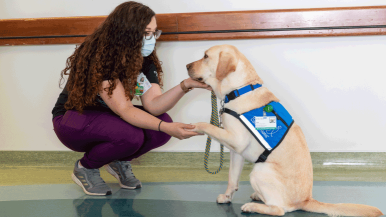A new full-time staff member at Rush University Children’s Hospital is already having a “paws-itive” impact on patients. Meet Tyra, the first facility dog at a children’s hospital in Chicago.
On her first day at work last month, the two-year-old yellow Lab got her own RUSH photo ID badge showing that she is part of the new facility dog program within child life services called “Puppyatrics,” made possible by a generous grant from the Dunkin’ Joy in Childhood Foundation’s Dogs for Joy program. Tyra’s work uniform is a blue-and-white vest from Canine Companions, the California-based non-profit organization that provides facility dogs for health care and other settings and service dogs for people with disabilities free of charge.
“You can definitely see a switch in Tyra’s demeanor when she has her vest on — she knows she’s at her job,” says Megan Hartnett, MS, a certified child life specialist who serves as Tyra’s handler at RUSH. Together, they help kids — many who are chronically ill — cope with the discomfort and disruption of hospitalization.
Facility dogs are meant to work
Unlike therapy dogs (which are pet dogs that have been granted permission to provide emotional support during a visit to the hospital), certified facility dogs like Tyra play a much different role. They are specially bred, raised and trained for two years to work full time in a hospital and assist other members of the care team.
“While Tyra does provide emotional support to kids, she also does so much more,” Hartnett says. “We have a menu of different interventions that Tyra can help us with to help kids cope with the stress of hospitalization.”
A typical day for Tyra
On any given day at RUSH, you might see a doctor doing a mock eye exam on Tyra so a young patient knows what to expect and is less distressed during their own examination. Or you might see Tyra playing a quiet game with a patient to keep their mind off getting poked by a needle. But one of Tyra’s favorite jobs is inspiring surgical patients to walk with her during physical therapy.
“If a patient can ambulate faster after surgery because Megan and Tyra motivate them to move, the child can go home to their family faster,” says Shira Miller, MS, manager of child life and creative arts therapies.
Like other evidence-based child life interventions, facility dogs can benefit kids physiologically and emotionally. “We know that working with animals helps decrease the heart rate and blood pressure,” Miller says. “It can also distract patients from pain and lower their stress and anxiety.”
What’s more, facility dogs like Tyra can unleash a sense of unconditional acceptance and support that helps kids of all ages express what they are feeling. “Dogs don’t talk back, and there’s no judgment,” Miller says.
Helping kids regain their autonomy
Tyra has been trained to follow more than 40 different commands that Hartnett uses to help patients reach their goals in the hospital. When cued by Hartnett, Tyra can walk calmly beside a patient with an IV pole or crutch, carefully matching their energy and pace. She can also open and close doors and drawers, press elevator buttons, turn lights on and off, retrieve objects, pull a wagon and play games with young patients. With Hartnett’s help, kids can interact with Tyra by giving her commands.
Telling Tyra what to do can help kids overcome some of the powerlessness they feel when they are hospitalized. “Kids lose some of their ability to make choices and decisions in the hospital. They have to take their medicine. They have to get their vitals taken. But giving commands to Tyra through me gives them back some sense of control,” Hartnett says.
Canine consults
Tyra and Hartnett see patients by consultation in the general pediatric and pediatric intensive care units at RUSH. If a physician, nurse, physical therapist or other staff member thinks a young patient might benefit from working with Tyra, they will reach out to the unit’s child life specialist, who will assess if a visit from the Puppyatrics team is a good fit based on the child’s specific needs. If they think the patient could benefit, Hartnett and Tyra can be at the patient’s bedside — STAT.
When there is a break between seeing patients, Hartnett will use a command that gives Tyra permission to do something that other hospital staff can’t: take a quick nap on the job. “If something comes up, I just have to say her name, and she instantly is alert,” she says.
After what can sometimes be “ruff” days at work, Tyra heads back to Hartnett’s apartment and gets to be a regular dog. “When we get home, I take off her vest and give her the ‘release’ command, and then she likes to play fetch or circle around my legs and just get petted,” Hartnett says.
But Tyra can’t pick up bad behaviors at home like not obeying commands, which could affect her job performance.
Supporting young patients in innovative ways
Because RUSH is a research-driven medical center, the child life team plans to track psychosocial outcomes from patients who interact with Tyra to see how their anxiety and stress levels change after therapy.
The child life services team at RUSH has a long history of using innovative programming to enhance the psychosocial care of kids, or what the child life team at RUSH calls “playing with purpose.” Rush University Children’s Hospital was the pilot site in Chicago for a martial arts and mindfulness program, Kids Kicking Cancer. The hospital was also the first site in Chicago for a bedside magic program called Open Heart Magic and an arts and education program for hospitalized children, Snow City Arts.
Now that Tyra has joined the child life services team, young patients at RUSH have another creative — and cuddly — form of support at the bedside. For Hartnett, Tyra has already added greater joy and meaning to her work life while fulfilling her lifelong dream of having her own dog.
“I love my job,” Hartnett says. “And now I get to love it with somebody else.”
Learn more about Child Life Services at RUSH and follow Tyra on Instagram at @chicagosnexttopdog.




